Our Environment Class 10 Notes Science Chapter 13
| Table of contents |

|
| Introduction |

|
| Ecosystem- What are its Components? |

|
| Food Chains and Webs |

|
| How Do Our Activities Affect the Environment? |

|
Introduction
Our environment is a complex and dynamic system that supports all living beings. It consists of:
- Physical Factors: Natural elements like landforms, climate, temperature, rainfall, wind, soil, and minerals.
- Chemical Factors: Elements such as air, water, and soil, along with their chemical interactions.
- Biotic Factors: Living organisms, including plants, animals, and microorganisms, and their interactions within ecosystems.
In this chapter, we will delve into these components and their interconnections, understanding how they maintain the balance of ecosystems.

Ecosystem- What are its Components?
All living things, including plants, animals, microorganisms, and humans, interact with each other and their physical surroundings to create balance in nature. An ecosystem is the result of these interactions and includes both living components (biotic) and non-living elements (abiotic) like temperature, rainfall, wind, soil, and minerals. This system functions as a unified whole.
Types of Ecosystem
- Natural ecosystem: Ecosystems that exist independently in nature, such as forests, lakes, and oceans.
- Artificial ecosystem: Ecosystems created by humans, including crop fields, aquariums, and gardens.
Components of Ecosystem
1. Abiotic Components: All the non-living components such as air, water, land, light, temperature etc. form the abiotic components.
2. Biotic Components: All the living components such as plants, animals, bacteria, fungi etc. form the biotic components.
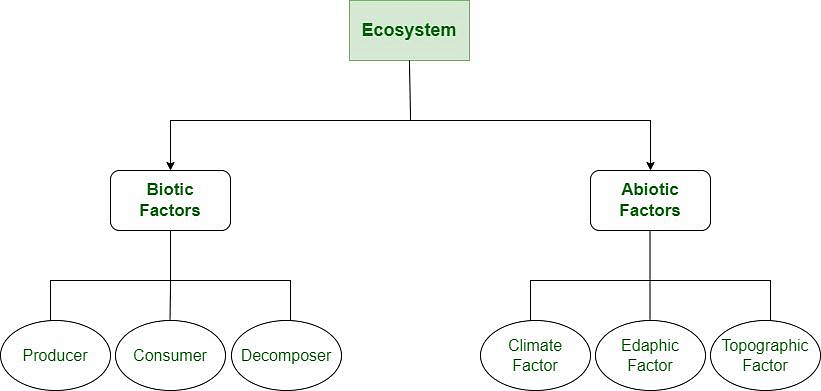 Components of Ecosystem
Components of Ecosystem
Organisms can be categorized as producers, consumers, and decomposers based on how they obtain sustenance from the environment.
1. Producers: All green plants and blue-green algae can produce their own food using abiotic components (photosynthesis), hence called producers.
2. Consumers: Include all animals which depend on producers directly or indirectly for their food.
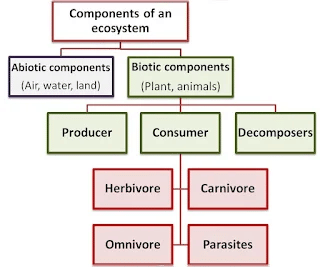 Division of ConsumersDivision of Consumers
Division of ConsumersDivision of Consumers
(i) Herbivores: Plant eaters. Example: goat, deer.
(ii) Carnivores: Flash eaters. Example: tiger, crocodile.
(iii) Omnivores: Eats both plants and animals. Example: human.
(iv) Parasites: Live on the body of the host and take food from it. Example: lice, cascuta.
3. Decomposers: Include organisms which decompose the dead plants and animals. Example: bacteria, fungi. These help in the replenishment of natural resources.
Food Chains and Webs
Food chain is a series of organisms in which one organism eats another organism as food. For example: Grass → Deer → Lion

Trophic Levels in a Food Chain
Trophic Levels: The steps in a food chain where energy transfer occurs.
- First Trophic Level: Occupied by autotrophs or producers (e.g., green plants) that capture solar energy and make it available for consumers.
- Second Trophic Level: Consists of herbivores or primary consumers (e.g., deer).
- Third Trophic Level: Includes small carnivores or secondary consumers (e.g., fox).
- Fourth Trophic Level: Occupied by larger carnivores or tertiary consumers (e.g., lion).
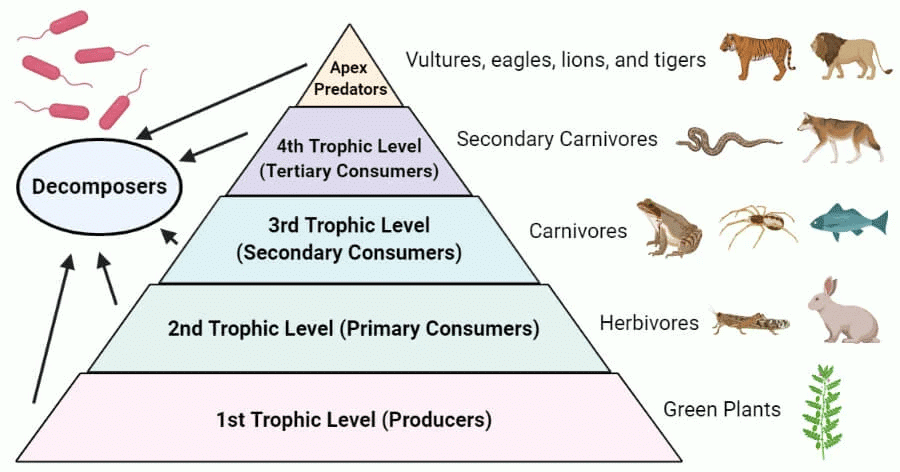 Trophic Levels
Trophic Levels
- The interactions among the components of the environment involve the transfer of energy from one component to another.
- Autotrophs capture solar energy and convert it into chemical energy, which supports all living activities.
- Energy flows from autotrophs to heterotrophs and decomposers.
- Some energy is lost to the environment when one form of energy is converted to another.
- Green plants in a land environment take in around 1% of the sunlight that hits their leaves and change it into food.
- When green plants are consumed by animals that eat plants, a lot of energy is lost as heat to the surroundings.
- Only about 10% of the food that plant-eating animals consume becomes part of their own bodies and is accessible to the animals that eat them.
- As a result, roughly 10% of the material from living things goes on to the next group of animals in the food chain at each level.
 10 percent energy flow rule
10 percent energy flow rule
- Due to the significant energy loss at each step, food chains generally consist of only three or four trophic levels.
- There are typically more individuals at the lower trophic levels of an ecosystem, with the greatest number being the producers.
Food Web
- Food chains can vary in length and complexity, and each organism is usually eaten by multiple other organisms.
- This relationship can be represented as a food web, which consists of branching lines instead of a straight-line food chain.
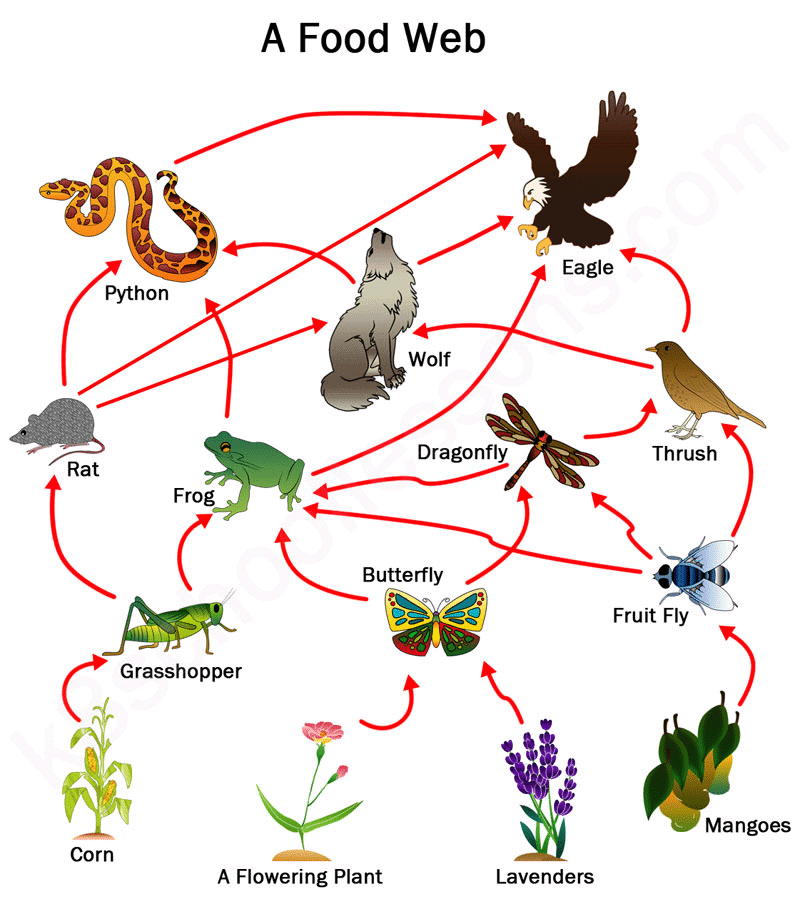
Energy Flow in Ecosystems
From the energy flow diagram, two key observations can be made:
1. Unidirectional Flow:
- Energy flows in a one-way direction.
- Energy captured by autotrophs (producers) does not return to the solar input, and energy transferred to herbivores does not revert to autotrophs.
- As energy progresses through different trophic levels, it becomes unavailable to previous levels.
2. Progressive Diminishment:
- The amount of energy available at each trophic level decreases progressively.
- This reduction occurs due to energy loss at each level, typically as heat and metabolic waste.
Harmful chemicals from pesticides and crop protection products enter our bodies through the food chain. They are absorbed by plants and animals, ultimately accumulating in humans at the top of the food chain. This is why pesticide residues can be found in food grains, vegetables, fruits, and meat, and they are not always removable through washing or other methods.
How Do Our Activities Affect the Environment?
Changes in the environment affect us and our activities change the environment around us. Human activities leads to pollution, deforestation etc.
Ozone Layer and How it is Getting Depleted?
- The ozone layer is a protective blanket around the earth that absorbs most of the harmful UV (ultraviolet) radiations of the sunlight, thus protecting living beings from many health hazards such as skin cancer, cataracts, destruction of plants, etc.
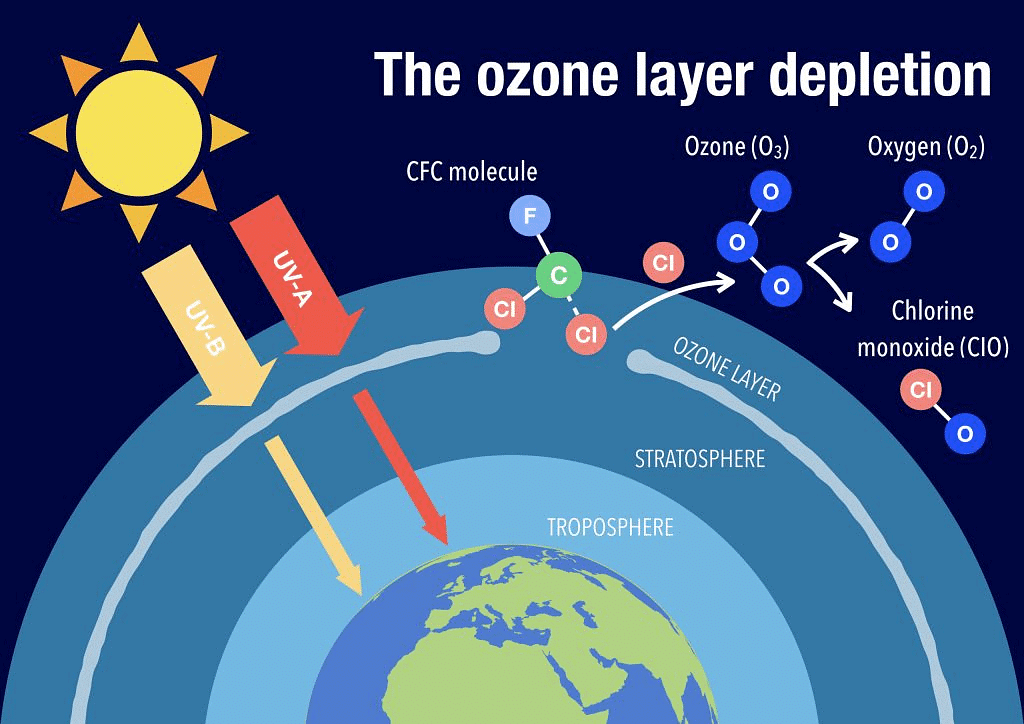 Ozone Layer Depletion
Ozone Layer Depletion
- Ozone is a molecule made up of three oxygen atoms, while oxygen (O2) is essential for aerobic life.
- Ozone is a deadly poison, but it plays a crucial role in shielding the Earth's surface from harmful UV radiation from the Sun.
- UV radiation in the higher levels of the atmosphere causes molecular oxygen (O2) to split into free oxygen (O) atoms, which then combine with more molecular oxygen to form ozone.
O →(UV) O + O (atoms)
O2 + O → O3 (ozone)
Ozone Depletion and International Response
- Sharp Decline: The amount of ozone in the atmosphere began to decrease significantly in the 1980s.
- Cause: This decline has been linked to synthetic chemicals such as chlorofluorocarbons (CFCs), which are used in refrigerants and fire extinguishers.
- International Agreement: In 1987, the United Nations Environment Programme (UNEP) established an agreement to freeze CFC production at 1986 levels.
- Current Mandates: It is now mandatory for all manufacturing companies worldwide to produce CFC-free refrigerators.
Managing the Garbage we Produce
- Enzyme Specificity: Enzymes in our body are specialized and can only break down specific substances. This is why we cannot derive energy from non-digestible materials like coal.
- Persistence of Human-Made Materials: Many synthetic materials, such as plastics, are not decomposed by bacteria or other organisms. As a result, these materials can remain in the environment for extended periods.
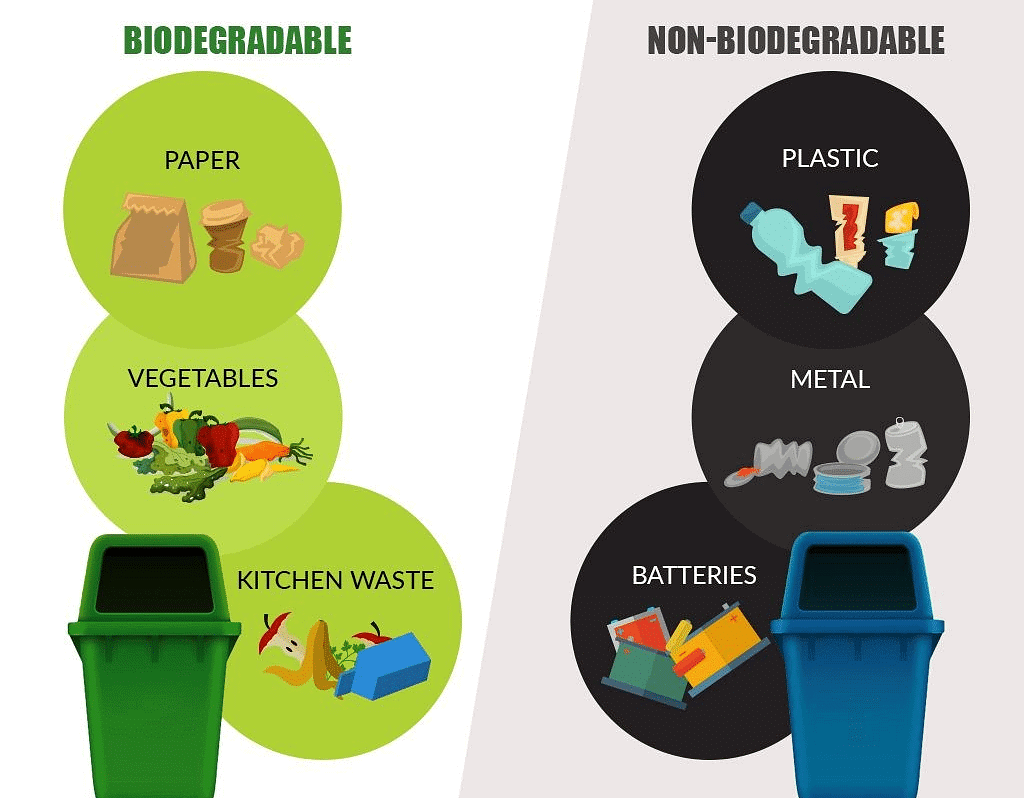
Types of materials in Garbage
(i) Biodegradable: Substances that can be decomposed by the action of microorganisms are called biodegradable wastes.
Example: fruit and vegetable peels, cotton, jute, dung, paper, etc.
(ii) Non-biodegradable wastes: Substances that cannot be decomposed by the action of microorganisms are called non-biodegradable wastes.
Example: plastic, polythenes, metals, synthetic fibres, radioactive wastes, pesticides etc.
- Garbage and litter can be found in towns, cities, and tourist areas.
- Changes in lifestyle and attitudes have led to increased waste generation.
- Disposable products and non-biodegradable packaging contribute to the problem.
- The impact of these factors on the environment is a concern.
What You Have Learned
- The parts of an ecosystem depend on each other to work properly.
- Plants (producers) use sunlight to create energy, which is then passed on to other organisms in the ecosystem.
- As energy moves through the food chain, some is lost at each step, so food chains usually have only a few levels.
- Human actions affect the environment in many ways.
- Chemicals like CFCs have harmed the ozone layer, which protects us from the Sun's harmful ultraviolet rays. This can cause serious damage to the environment.
- The waste we create can be biodegradable (can break down naturally) or non-biodegradable (does not break down easily).
- Improper disposal of waste is leading to major environmental problems.
|
80 videos|569 docs|80 tests
|
FAQs on Our Environment Class 10 Notes Science Chapter 13
| 1. What are the main components of an ecosystem? |  |
| 2. How do human activities impact ecosystems? |  |
| 3. What is the importance of biodiversity in an ecosystem? |  |
| 4. How can individuals help protect the environment? |  |
| 5. What are some examples of ecosystem services? |  |
















